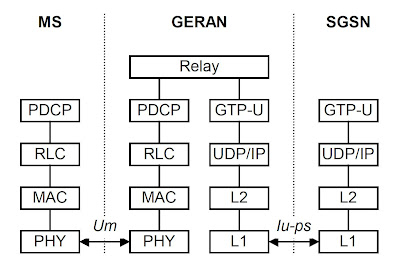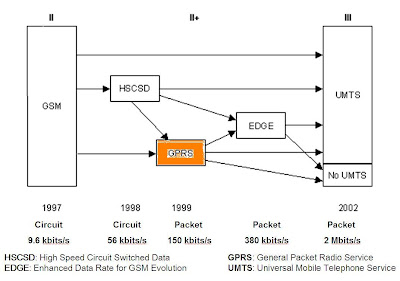Code Division Multiple Access (CDMA) is a method for transmitting simultaneous digital signals over a shared portion of the spectrum. As a competing technology to its European GSM peer and its successors, this American technology initiates an alternative cellular system implementation.
1. CDMAone
CDMAone refers to the original ITU IS-95 (CDMA) wireless interface protocol that was first standardized in 1993 and employed to build up the first CDMA cellular network. In the mobile network evolution term, CDMAone is considered as a second-generation (2G) mobile wireless technology.
There are two versions of IS-95, called IS-95A and IS-95B. The IS-95A protocol employs a 1.25-MHz carrier, operates in radio-frequency bands at either 800 MHz or 1.9 GHz, and supports data speeds of up to 14.4 Kbps. IS-95B can support data speeds of up to 115 kbps by bundling up to eight channels.

2. CDMA2000 Overview
CDMA2000 represents a family of standards which includes technologies as listed below. CDMA2000 is also known by its ITU name, IMT-2000 CDMA Multi-Carrier (MC).
i. CDMA 2000 1x
ii. CDMA 2000 1x EV DO
a) CDMA2000 1xEV-DO Release 0
b) CDMA2000 1xEV-DO Revision A (Rev A)
c) CDMA2000 1xEV-DO Revision B(Rev B)
d) CDMA2000 1xEV-DO Revision C(Rev C)
iii. CDMA 2000 1x EVDV
iv. CDMA 2000 3x
The CDMA 2000 standard was divided into two phases 1x and 3x. 1x is used to refer that the standard carrier on the air interface is 1.25 MHz, which is the same as for IS-95A/B. 3X is a multi-carrier approach, and is used to refer 3 times standard carrier of 1.25 MHz i.e. 3.75 MHz.
CDMA 2000 1x utilizes a single carrier of 1.25 MHz of radio spectrum as IS-95. However, it uses a different vocoder and walshcodes, 256/ 128 verses 64, allowing for higher data rates and more voice conversions than are possible over cdmaOne systems. 1x EV-DO means one carrier, which is data only, while 1x EV-DV means one carrier that supports data and voice services. However, when referring to CDMA 2000 3x, the use of 3.75 MHz of the spectrum, or 3x1.25 MHz, is defined with a change in the modulation scheme as well as the vocoders.
3. CDMA2000 1xRTT
CDMA2000 1xRTT is considered as a 2.5G (or 2.75G) technology. CDMA2000 1xRTT is the core CDMA2000 wireless air interface standard and is also known as 1x, 1xRTT, and IS-2000. The designation "1x", meaning "1 times Radio Transmission Technology", indicates the same RF bandwidth as IS-95 (CDMA-One): a duplex pair of 1.25 MHz radio channels. 1xRTT almost doubles the capacity of IS-95 by adding 64 more traffic channels to the forward link, orthogonal to the original set of 64. Although capable of higher data rates, most deployments are limited to a peak of 144 kbit/s. IS-2000 also made changes to the data link layer for the greater use of data services, including medium and link access control protocols and QoS.

4. CDMA2000 EV-DO
CDMA2000 EV-DO (Evolution-Data Optimized or Evolution-Data only) is refered as the CDMA version of 3G technology. It is a broadband access radio technology standardized by 3rd Generation Partnership Project 2 (3GPP2), provides access to mobile devices with air interface speeds of up to 2.4 Mbit/s with Rev. 0, up to 3.1 Mbit/s with Rev. A, upto 14.7 Mbit/s with Rev. B and upto 200 Mbit/s with Rev. C, etc.

CDMA2000 1xEV-DO requires a multi-mode device to be fully backward compatible with 1X and cdmaOne systems to support the all-IP network and the air interface that has been optimized for data.
CDMA2000 1xEV-DO Rev.0 provides a peak data rate of 2.4 Mbps in the forward link and 153 kbps in the reverse link in a 1.25 MHz CDMA carrier. With average throughput of 400-800 kbps in the forward link.
CDMA2000 1xEV-DO Rev A is an enhanced version of Rev.0,represents a major step in the evolution of CDMA2000 standards towards converged communication networks and ubiquitous delivery of voice and data services across fixed and wireless networks. The key features that the Rev.A provides are:
• High-speed data: Delivers a peak data rate of 1.8 Mbps on the reverse link and 3.1 Mbps on the forward link.
• Higher system capacity: Improves sector capacity within the 1.25 MHz channel. It has twice the sector capacity on the down link and is 1.2 times higher on the forward link compared to Release 0.
• Improved Quality of Service (QoS): Lower latency, prioritization of low-latency applications and QoS software enhancements added to Revision A improve performance of delay-sensitive applications such as VoIP, push-to-talk, instant messaging and video telephony.
• VoIP: Is possible because of the high data rate on the reverse link, lower latency and improved QoS.
CDMA 2000 1x Ev-DO Rev-B introduces a 64-QAM modulation scheme and will deliver peak rates of 73.5 Mbps in the forward link and 27 Mbps in the reverse link through the aggregation of 15, 1.25 MHz carriers within 20 MHz of bandwidth. A single 1.25 MHz carrier and an aggregated 5 MHz carrier in the forward link will deliver a peak rate of up to 4.9 Mbps and 14.7 Mbps, respectively.
CDMA 2000 1x Ev-DO Rev-C delivers higher data rates and spectral efficiency along with low latency, making it ideal for enriched multimedia services. Revision C supports flexible and dynamic channel bandwidth scalability from 1.25 MHz up to 20 MHz and are backward-compatible with Revisions A and B. Revision C not only increases the peak rates up to 200 Mbps in the downlink but also provides significant gain in sector throughput.
5. CDMA2000 EV-DV
CDMA2000 EV-DV supports up to 3.1 Mbps forward link throughput. One of the advantageous of EV-DV is its ability to give carriers both voice and broadband data on a single channel, using the same legacy digital voice technology operating over current 1x networks.
EV-DV has been commercially unsuccessful due to lack of carrier interest.

6. CDMA2000 3x
CDMA2000 3x is an ITU-approved third-generation (3G) mobile wireless technology. It is also known as Multi-Carrier or MC.
CDMA2000 3x utilizes a pair of 3.75-MHz radio channels (i.e., 3 X 1.25 MHz) to achieve higher data rates. The 3x version of CDMA2000 has not been deployed and is not under development at present.
























